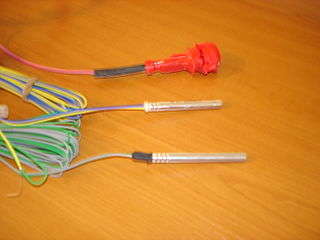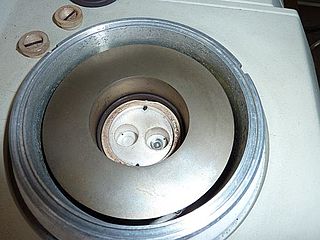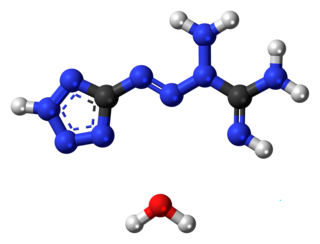
An explosive is a reactive substance that contains a great amount of potential energy that can produce an explosion if released suddenly, usually accompanied by the production of light, heat, sound, and pressure. An explosive charge is a measured quantity of explosive material, which may either be composed solely of one ingredient or be a mixture containing at least two substances.

Pentaerythritol tetranitrate (PETN), also known as PENT, PENTA, TEN, corpent, or penthrite, is an explosive material. It is the nitrate ester of pentaerythritol, and is structurally very similar to nitroglycerin. Penta refers to the five carbon atoms of the neopentane skeleton. PETN is a powerful explosive material with a relative effectiveness factor of 1.66. When mixed with a plasticizer, PETN forms a plastic explosive. Along with RDX it is the main ingredient of Semtex.

2,4,6-Trinitrophenylmethylnitramine commonly referred to as tetryl (C7H5N5O8) is an explosive compound used to make detonators and explosive booster charges.

A detonator, frequently a blasting cap, is a device used to trigger an explosive device. Detonators can be chemically, mechanically, or electrically initiated, the last two being the most common.

Differential scanning calorimetry (DSC) is a thermoanalytical technique in which the difference in the amount of heat required to increase the temperature of a sample and reference is measured as a function of temperature. Both the sample and reference are maintained at nearly the same temperature throughout the experiment. Generally, the temperature program for a DSC analysis is designed such that the sample holder temperature increases linearly as a function of time. The reference sample should have a well-defined heat capacity over the range of temperatures to be scanned.

C-4 or Composition C-4 is a common variety of the plastic explosive family known as Composition C, which uses RDX as its explosive agent. C-4 is composed of explosives, plastic binder, plasticizer to make it malleable, and usually a marker or odorizing taggant chemical. C-4 has a texture similar to modelling clay and can be molded into any desired shape. C-4 is metastable and can be exploded only by the shock wave from a detonator or blasting cap.
An explosive booster is a sensitive explosive charge that acts as a bridge between a conventional detonator and a low-sensitivity explosive such as TNT. By itself, the initiating detonator would not deliver sufficient energy to set off the low-sensitivity charge. However, it detonates the primary charge, which then delivers an explosive shockwave that is sufficient to detonate the secondary, main, high-energy charge.
A triggering sequence, also called an explosive train, is a sequence of events that culminates in the detonation of explosives. For safety reasons, most widely used high explosives are difficult to detonate. A primary explosive of higher sensitivity is used to trigger a uniform and predictable detonation of the main body of the explosive. Although the primary explosive itself is generally a more sensitive and expensive compound, it is only used in small quantities and in relatively safely packaged forms. By design there are low explosives and high explosives made such that the low explosives are highly sensitive and high explosives are comparatively insensitive. This not only affords inherent safety to the usage of explosives during handling and transport, but also necessitates an explosive triggering sequence or explosive train. The explosive triggering sequence or the explosive train essentially consists of an 'initiator', an 'intermediary' and the 'high explosive'.

Gas chromatography (GC) is a common type of chromatography used in analytical chemistry for separating and analyzing compounds that can be vaporized without decomposition. Typical uses of GC include testing the purity of a particular substance, or separating the different components of a mixture. In preparative chromatography, GC can be used to prepare pure compounds from a mixture.
Figure of Insensitivity is an inverse scale of measure of the impact sensitivity of an explosive substance. In this particular context the term 'Insensitivity' refers to the likelihood of initiation/detonation by accidental means e.g. impact, friction, electrostatic discharge, application of flame, etc. It is a quantitative measure of the level of stimulus required to cause initiation, typically by shock/impact.
A Bruceton analysis is one way of analyzing sensitivity and sensitiveness tests of explosives as described originally by Dixon and Mood in 1948. Also known as the "Up and Down Test" or "the staircase method", a Bruceton analysis relies upon two parameters: first stimulus and step size. A stimulus is provided to the sample, and the results noted. If a positive result is noted, then the stimulus is decremented by the step size. If a negative result occurs, the stimulus is increased. The test continues with each sample tested at a stimulus 1 step up or down from the previous stimulus if the previous result was negative or positive.

Mannitol hexanitrate is a powerful explosive. Physically, it is a powdery solid at normal temperature ranges, with density of 1.73 g/cm3. The chemical name is hexanitromannitol and it is also known as nitromannite, MHN, and nitromannitol, and by the trademarks Nitranitol and Mannitrin. It is more stable than nitroglycerin, and it is used in detonators.
Shock sensitivity is a comparative measure of the sensitivity to sudden compression of an explosive chemical compound. Determination of the shock sensitivity of a material intended for practical use is one important aspect of safety testing of explosives. A variety of tests and indices are in use, of which one of the more common is the Rotter Impact Test with results expressed as FoI At least four other impact tests are in common use, while various "gap tests" are used to measure sensitivity to blast shock.

Hexamethylene triperoxide diamine (HMTD) is a high explosive organic compound. HMTD is an organic peroxide, a heterocyclic compound with a cage-like structure. It is a primary explosive. It has been considered as an initiating explosive for blasting caps in the early part of 20th century, mostly because of its high initiating power and its inexpensive production. As such, it was quickly taken up as a primary explosive in mining applications. However, it has since been superseded by more (chemically) stable compounds such as dextrinated lead azide and DDNP. HMTD is widely used in amateur made blasting caps.
The Neyer d-optimal test is a sensitivity test. It can be used to answer questions such as "How far can a carton of eggs fall, on average, before one breaks?" If these egg cartons are very expensive, the person running the test would like to minimize the number of cartons dropped, to keep the experiment cheaper and to perform it faster. The Neyer test allows the experimenter to choose the experiment that gives the most information. In this case, given the history of egg cartons which have already been dropped, and whether those cartons broke or not, the Neyer test says "you will learn the most if you drop the next egg carton from a height of 32.123 meters."
A pyrotechnic fastener is a fastener, usually a nut or bolt, that incorporates a pyrotechnic charge that can be initiated remotely. One or more explosive charges embedded within the bolt are typically activated by an electric current, and the charge breaks the bolt into two or more pieces. The bolt is typically scored around its circumference at the point(s) where the severance should occur. Such bolts are often used in space applications to ensure separation between rocket stages, because they are lighter and much more reliable than mechanical latches.
A pyrotechnic composition is a substance or mixture of substances designed to produce an effect by heat, light, sound, gas/smoke or a combination of these, as a result of non-detonative self-sustaining exothermic chemical reactions. Pyrotechnic substances do not rely on oxygen from external sources to sustain the reaction.

Erythritol tetranitrate (ETN) is an explosive compound chemically similar to PETN, though it is thought to be slightly more sensitive to friction and impact.

Tetrazene is an explosive material used for sensitization of priming compositions. It is a derivative of the compound with the IUPAC name tetrazene.
Sensitivity of explosives is the degree to which an explosive can be initiated by impact, heat, or friction.










